A Masonic Conundrum – Will the real James Anderson please stand up?
Most Freemasons will have read – or at least are aware of – the Constitutions of Freemasonry.
Shortly after the foundation of Grand Lodge of London and Westminster (later Grand Lodge of England), the Rev. James Anderson, a Scottish writer, and minister, was assigned the task of completing a full digest of the Fraternity’s Constitutions.
At the time he was commissioned, in 1721, he was Master of a lodge and Grand Warden of the Grand Lodge of London and Westminster.
He presented his completed volume dated 1723, entitled:
The Constitutions of the Free-Masons; containing the History, Charges, Regulations, &c. of that Most Ancient and Right Worshipful Fraternity. For the Use of the Lodges. London. In the year of Masonry 5723, Anno Domini 1723.
The work, known as Anderson’s Constitutions, passed through several editions and was long recognised by the English Freemasons to be the standard text on the subject.
Anderson’s name does not appear as the author on the title page but is stated in the appendix.
Over the years, many Freemasons have sought to know more about the man behind the Constitutions and for most of those years, they would have become familiar with this image of James Anderson.
He certainly looks the part, right era of dress, suitably scholarly and conservative deportment, so far so good? So far, so wrong!
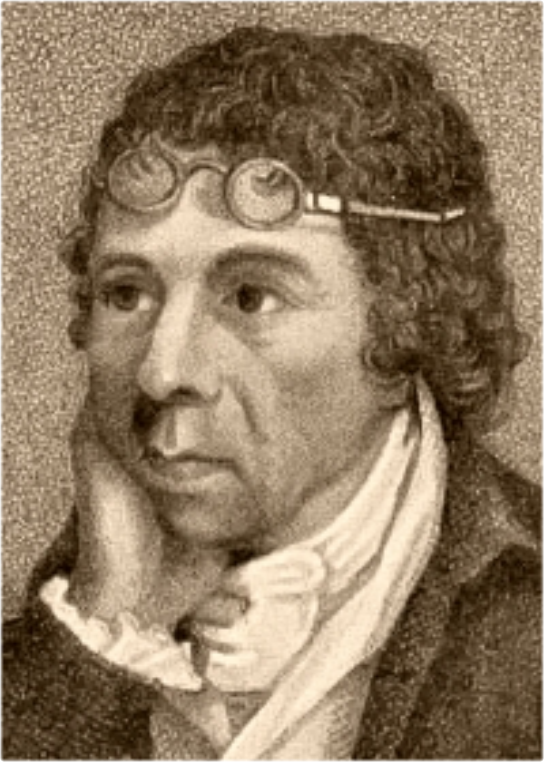
This image is repeatedly utilised by Masonic websites etc., but apparently it is not the James Anderson of the Book of Constitutions fame – it is James Anderson of Hermiston, a Scottish agriculturalist, journalist and economist; the inventor of the Scotch Plough!
Further According to an addendum on the biography of Anderson on Freemasonry BCY website, it confirms that in fact it is an engraving of the economist, Dr James Anderson (1739-1808) which appeared in the Gentleman’s Magazine of May 1809. AQC vol. lxxvii (1964), p. 17.
Source: freemasonry.bcy.ca
So, who was our man? According to a few internet sources, this is the real James Anderson…yes!! We thought we’d cracked it!

There are three instances where this image turned up:
1. Printed within The Evangelical magazine and missionary chronicle. … n.s.v.5 (1827) page 412 [Digitised by Google, original copy from Harvard University – in the public Domain]
1. Found on Wikimedia Commons and attributed to Llyfrgell Genedlaethol Cymru – The National Library of Wales [MISSING RIGHTS STATEMENT]
AS the copyright usage for this image is uncertain, we have image-linked it to the NLW and…
3. Also via a link to the British Museum where it is under copyright licence but does not mention this James Anderson as a ‘Freemason’ when searched for under that term. https://www.britishmuseum.org/collection/object/P_1872-0810-423
The description tells us that it is a:
Portrait of James Anderson, half-length, slightly turned to the left, dressed in an academic gown over his double-breasted tailcoat with bands at his neck, illustration to the Evangelical Magazine (1827)
Stipple
Producer name
Print made by: John Roffe (1769-1850)
After: Charles Penny (?)
Published by: Westley & DavisInscription content: Lettered below image “Drawn by Penny.” “Engraved by Roffe.” “Rev.d James Anderson, Dumblane, Scotland.” and “Pub.d Oct 1827, by Westley & Davis, Stationers Court.”
BUT…this portrait of ‘Rev. James Anderson’ has the word ‘Dumblane’ [sic] associated with him – our James Anderson was born in Aberdeen – that’s a wee bit of a distance from Dunblane!
Back to the drawing board and we had a deeper search, finding that there was indeed a another Rev. James Anderson who was a Minister at St Blane’s, Dunblane, Scotland in the early 1800s.
Source: https://blantyreproject.com/2015/11/blantyre-minister-rev-james-anderson/
And so the plot thickens! Which is the real James Anderson?
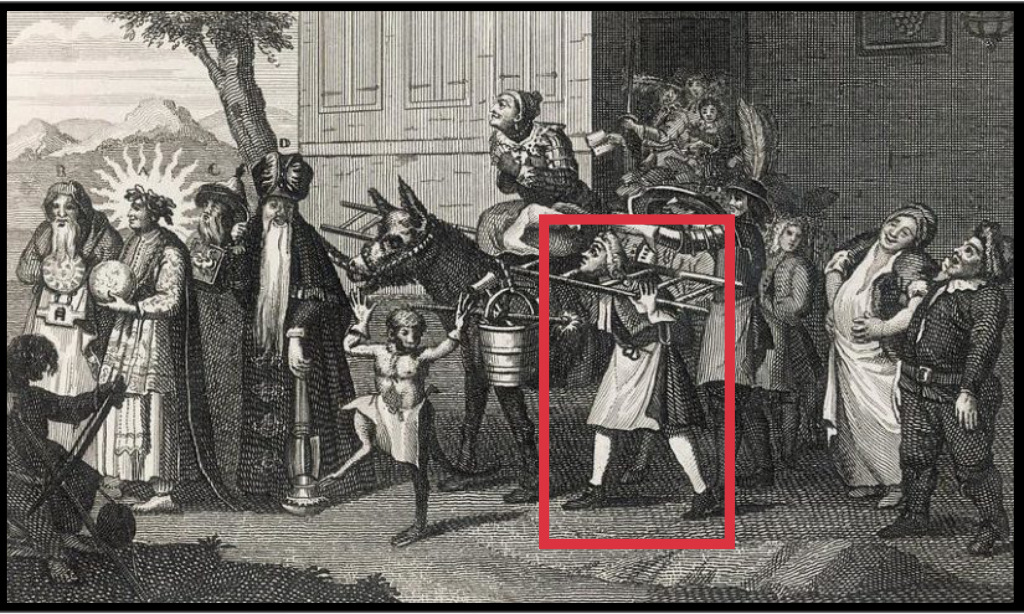
We are then just left with this image – possibly the only extant period ‘portrait’ of Anderson – in William Hogarth’s caricature The Mystery of Masonry brought to light by ye Gormagons.
The figure with his head through a ladder is believed to be James Anderson
Source: ‘William Hogarth and his Fraternity’, AQC. lxxvii (1964) pp. 14-18
This is a fascinating Masonic Conundrum – and a brilliant exercise in the convoluted detective work of research and how just one erroneous attribution can send us down the wrong track.
So, we don’t as yet have concrete proof of our elusive man – if he’s out there, will the real James Anderson please stand up?!
WANT TO WIN A PRIZE!!
Here’s a mission for you all – if one of you can find an image/portrait (and prove unequivocally) that it is the real James Anderson – you will win a special prize!
Email us: editor@thesquaremagazine.com
Anderson – Quick Bio and Links…maybe some clues as to where to search next:
James Anderson (c. 1679/1680 – 1739) was a Scottish writer and minister born and educated in Aberdeen, Scotland. He was ordained a minister in the Church of Scotland in 1707 and moved to London, where he ministered to the Glass House Street congregation until 1710, to the Presbyterian church in Swallow Street until 1734, and at Lisle Street Chapel until his death. He is reported to have lost a large sum of money in the South Sea Company crash of 1720. Anderson is best known for his association with Freemasonry. Possible brother of Adam Anderson (1692 or 1693 – 10 January 1765) a Scottish economist.
Source: wikipedia
Recent Articles: Masonic Miscellanies
 Masonic Miscellanies - The Amulet of the Ladder Explore the cosmic significance of the Ladder in ancient Egyptian mythology through Wallis Budge's "Egyptian Magic." Discover how this profound symbol bridges the mortal and divine, encapsulating the Egyptians' fervent afterlife aspirations with a blend of myth, magic, and material culture. Dive into the celestial ascent of Osiris and mortal souls. |
 Masonic Miscellanies - Adulterine Gilds Guilds, the associations that shaped medieval European society, were more than just organizations of artisans and merchants. They played a vital role in the economic and social development of towns and cities. This exploration delves into the intriguing concept of adulterine gilds and their interconnectedness with guilds, offering insight into the significance of legal authorization and recognition in medieval Europe. |
 Masonic Miscellanies - Masonic Orb Discover the fascinating world of Masonic ball watch fobs, intricately crafted with tiny pyramids that form a cross when opened. These decorative accessories were all the rage in the late 1800s and early 1900s, and they still hold a certain allure today. Explore the different varieties and symbols found on these unique pieces that carry deep Masonic meaning. |
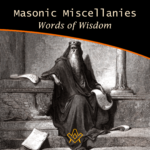 Masonic Miscellanies – Words of Wisdom Uncover timeless wisdom from King Solomon to Albert Pike in our latest Masonic Miscellanies, a treasure trove of insights for Masons. Journey through the ages and glean inspiring sayings, reflecting on their profound influence on Masonic principles. An enriching read for the enlightened. |
 Masonic Miscellanies - Symbolism of the Right Hand Unlock the enigmatic realm of Freemasonry as we delve into its age-old symbols, rituals, and philosophies. This thought-provoking exploration, drawn from Mackey's Revised Encyclopedia of Freemasonry, focuses on the iconic 'right hand' symbol - its rich history, universality, and profound significance. |
 Masonic Miscellanies - Order of the Secret Monitor Unveil the mystery of Freemasonry with 'The Order of the Secret Monitor'. Discover this lesser-known appendant order, its unique rituals, and the profound teachings it offers. Explore the bonds of friendship and brotherhood it fosters, all wrapped in an intriguing cloak of mystery. Your journey into the depths of Masonic wisdom begins here. |
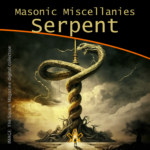 Masonic Miscellanies - The Symbol of the Serpent As a symbol, the serpent obtained a prominent place in all the ancient initiations and religions. |
 Masonic Miscellanies - The Four Veils in Royal Arch Masonry What are the four veils in Royal Arch Masonry? And what is the 'Ceremony of Passing the Veils'? Although common throughout Scotland, Ireland and the United States, it is mostly unknown in England, presently only worked in the Province of Bristol. ( and by dispensation ) |
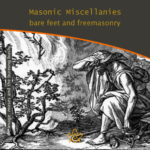 Masonic Miscellanies - Bare feet and Freemasonry A candidate for initiation into a Masonic Lodge often finds the requirements which he/she must fulfil somewhat odd. The mode of preparation often remains a puzzle, since the ritualistic explanation is not offered in full. Why are we 'slipshod' or "bare-footed" in Masonic Ritual? |
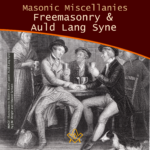 Masonic Miscellanies – Freemasonry and Auld Lang Syne Millions of people throughout the world will sing Auld Lang Syne to see out the Old Year. Few will know all the words, fewer still know what they mean, or that there is a link to Freemasonry. |
 Masonic Miscellanies - The Mosaic Pavement - why mosaic, why pavement? We are all familiar with the black and white chequered flooring of the Masonic lodge but where did it originate? There are a few theories… |
 Masonic Miscellanies – Masonic Master's Carpets Have you got a magic "Masonic Master's Carpet" in your lodge? I say 'magic' with my tongue firmly in my cheek because (as far as I know) these fabulous works of art don't bestow any mystical powers but can bestow some educational ones! However, considering their possible value today, they may magic up some interest (or funds). |
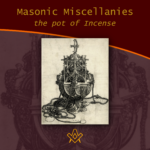 Masonic Miscellanies – The Pot of Incense Just when the pot of incense became an emblem of the third section of the Sublime Degree can not be stated with certainty. It is, apparently, an American invention or addition. But what does it symbolise? |
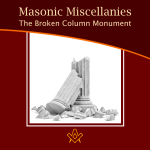 Masonic Miscellanies - The Broken Column Monument The story of the broken column was first illustrated by Amos Doolittle in the "True Masonic Chart" by Jeremy Cross, published in 1819. |
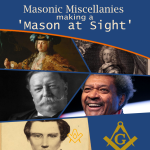 Masonic Miscellanies - Making a 'Mason at Sight' What does it mean to make a 'Mason at sight', and who was made one? |
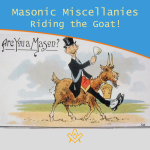 Masonic Miscellanies - Riding the Goat! Many Freemasons will have come across the phrase 'riding the goat', and will no doubt have been the butt of a joke about it (sorry, I couldn't resist!) But what does it mean and where did the phrase come from? |
 Masonic Miscellanies - What are the 'three dots'? Three dots or points in an upright triangular shape ∴ is most commonly known as the 'therefore' sign – so why is it used in Freemasonry? |
 Masonic Miscellanies - Keep Within Compass This month we discover a series of allegorical prints warning us to "Keep within Compass and you shall be sure, to avoid many troubles which others endure." |
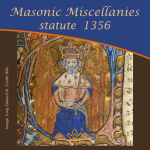 Masonic Miscellanies - statute 1356 Further to the reference in the article – The Builders - 6 - Free-Masons 'a statute was enacted against the Free-masons in 1356' – Regulations for masons who are hewers, on the one hand, and the light masons and setters on the other. |
 Masonic Miscellanies - An Anti-Masonic 'Apron'? The Anti-Masonic 'Apron' was created during the 1832 Presidential election in USA. It was not Ani-masonic. And it was not an apron. Read on to find out what and why it was created. |
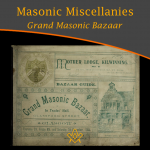 Masonic Miscellanies - Grand Masonic Bazaar (1895) Grand Masonic Bazaar (1895); to raise funds to clear the debt incurred by “Mother Kilwinning” in rebuilding their Lodge. |
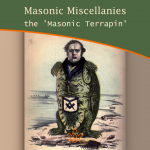 Masonic Miscellanies - the 'Masonic Terrapin' A satirical book from 1851 includes a bizarre caricature of a 'Masonic Terrapin' - all I can say is 'read on'… |
 Masonic Miscellanies - Masonic Bookplates You probably know what a bookplate is for, but did you know that the earliest known book mark/label dates from the reign of Amenhotep III in Egypt around 1391−1353 BCE?! |
 Masonic Miscellanies - Freemasonry & Bees Freemasonry & Bees - what's the buzz? The bee was among the Egyptians the symbol of an obedient people, because, says Horapollo, of all insects, the bee alone had a king. |
 Masonic Miscellanies - The mystery of the Tattooed Freemason In 1894, the body of a drowned man was found in the Bay of San Francisco - what they discovered was amazing. |
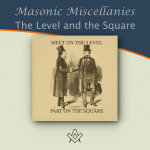 Masonic Miscellanies - The Level and the Square (A Poem) The Level and the Square (A Poem) - "We meet upon the Level, and we part upon the Square – |
 Masonic Miscellanies - The Mystic Tie What is the 'Mystic Tie'? Clue: it's not an item of neckwear! |
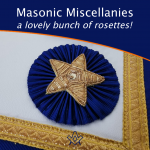 Masonic Miscellanies - A lovely bunch of rosettes! Where did the origin of the use of rosettes on Masonic aprons come from ? |
 Masonic Miscellanies - The Lodge of Sorrow The Lodge of Sorrow - Extracted General Ahiman Rezon, by Daniel Sickles, [1868] |
 Masonic Miscellanies - Memento Mori Memento Mori - a Masonic reminder to make your mark on the world |
 Masonic Miscellanies - A closer look at the Level and the Plumb-rule A closer look at the Level and the Plumb-rule |
 Masonic Miscellanies - The Symbolism of the Gloves The Symbolism of the Gloves and why Freemasons wear white gloves |
 Masonic Miscellanies - Will the real James Anderson please stand up? Will the real James Anderson please stand up? |
 Masonic Miscellanies - The Legend of the Third Degree The most important and significant of the legendary symbols of Freemasonry is, undoubtedly, that which relates to the fate of Hiram Abif. |
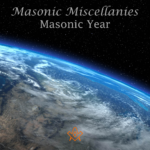 Masonic Miscellanies - Masonic Calendar Why do Freemasons use different 'years' to our regular calendar? |
 Masonic Miscellanies - What is a 'Lewis'? The English word 'Lewis' is a term belonging to operative Masonry, and signifies an iron cramp, which is inserted in a cavity prepared for the purpose in a large stone. |
 Masonic Miscellanies - From J.S.M. Ward Ever wondered why masons had to be 'free' or why we have a Tyler? |
masonic knowledge
to be a better citizen of the world
share the square with two brothers

click image to open email app on mobile device









